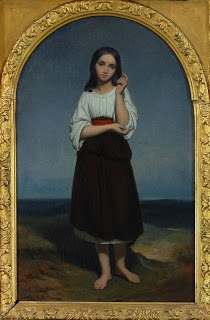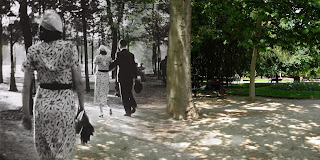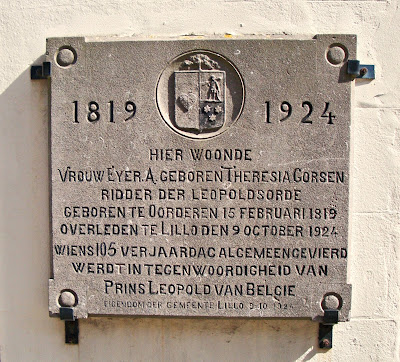Down at the Chinese café
Wednesday, September 26, 2012
Sehnsucht: An exhibition
Saturday, August 25, 2012
Ghost village life
A plaque on the wall in the village of Lillo-Fort in the area of the port of Antwerp, commemorating the life of Theresia Eyer née Gorsen, who was born in one vanished village, and died in another. Were it not for this plaque, there would likely be no record of her remaining.
Allow me to explain.
The village of Oorderen is first referred to in 1116. 850 years later it no longer exists, havng been evacuated and razed to the ground in 1965 to make way for the expansion of the port of Antwerp. Where Oorderen used to stand is now the former plant of Opel Antwerp, now itself lying disused, and the Antwerp-North railway training station. Of Oorderen nothing remains; of the neighbouring village of Wilmarsdonk, also razed in 1965, a lonely church steeple standing alone surrounded by stacked shipping containers.
 Lillo, meanwhile, also largely disappeared as a result of expansion of port facilities. The town was first known, by the name of Lindelo, in the ninth century, and in succeeding centuries became a thriving community. Until 1966, when the demands of trade took over. All that remains of Lillo now is the tiny centre known as Lillo-Fort, built in 1579 to strengthen the defences of the Scheldt river from an expected Spanish attack. Antwerp itself fell in 1585, but the fort remained in the hands of the Netherlandish resistants. You can still see the church, the former barracks and the gunpowder magazine, as well as this house, where Theresia Eyer-Gorsen's plaque is displayed.
Lillo, meanwhile, also largely disappeared as a result of expansion of port facilities. The town was first known, by the name of Lindelo, in the ninth century, and in succeeding centuries became a thriving community. Until 1966, when the demands of trade took over. All that remains of Lillo now is the tiny centre known as Lillo-Fort, built in 1579 to strengthen the defences of the Scheldt river from an expected Spanish attack. Antwerp itself fell in 1585, but the fort remained in the hands of the Netherlandish resistants. You can still see the church, the former barracks and the gunpowder magazine, as well as this house, where Theresia Eyer-Gorsen's plaque is displayed.The inhabitants of what remains of Lillo now number 30 -- and a lot of tourists.
So much for the passage of Theresia Eyer-Gorsen, from one vanished village to another, and thence herself to eternity. What do we know of her?
Maria Theresia Gorsen was born, as we read, in 1819, and married André Eyer, a customs official, with whom she had seven children. She earned the nickname Moederke Eyer (Ma Eyer) because of her advanced age. On her centenary in 1919 she received a parade and a visit from King Albert I. Five years later Prince Leopold, later to become King Leopold III, showed up, as mentioned on the plaque. Moederke Eyer died in October that same year. She was buried in Lillo cemetery, and a statue raised outside the church. The statue has moved to Lillo-Fort, and her grave was moved in 1960 to the Schoonselhof cemetery in Antwerp city, in the company of poet Herman De Coninck, writer Willem Elsschot, cartoonish Jef Nys and singer La Esterella.
And still the disappearances go on. Across the river from Lillo is the village of Doel, whose fate has also been declared to be to vanish to make way for further port developments, this time on the left bank of the river, where the potential for expansion is still enormous. Doel is in the news right now because of problems at the nuclear power station (seen in the photo from the Lillo side). Just south of the station is the village proper, where the residents and their supporters refuse to give in to the bulldozers. Their protests have been both physical and judicial, and the issue drags on. Unfortunately, the ultimate result is certain to be what the villagers fear, as their neighbours in Oorderen, Wilmarsdonk, Oosterweel and Lillo feared before them. In 20 years, Doel will be no more than some picture postcards, forgotten websites and blog posts like this one, and somewhere, perhaps, a plaque or a gravestone commemorating someone whose home it once was, but who is now, like Theresia Gorsen, exiled in death.
(Photo of Wilmarsdonk church by LimoWreck/Wikimedia Commons)
Saturday, January 28, 2012
Let Me Enjoy
Sunday, September 18, 2011
Hamlet, Act I, Scene 2, search and replace
88 To give these mourning duties to your mother:
89 But, you must know, your father lost a mother;
90 That mother lost, lost hers, and the survivor bound
91 In filial obligation for some term
92 To do obsequious sorrow: but to persever
93 In obstinate condolement is a course
94 Of impious stubbornness; 'tis unmanly grief;
95 It shows a will most incorrect to heaven,
96 A heart unfortified, a mind impatient,
97 An understanding simple and unschool'd:
98 For what we know must be and is as common
99 As any the most vulgar thing to sense,
100 Why should we in our peevish opposition
101 Take it to heart? Fie! 'tis a fault to heaven,
102 A fault against the dead, a fault to nature,
103 To reason most absurd: whose common theme
104 Is death of mothers, and who still hath cried,
105 From the first corse till she that died to-day,
106 "This must be so."[...]
Who knows where the time goes?
I'm standing there drinking a very hoppy beer when a man approaches and asks if he may take my picture. Surprised, I agree. He asks for my email address and moves on. Later I see him again, he snaps me again and explains he's studying photography at the academy in Bruges, and this is for a project called "Strangers Passing".
The same evening the two photos landed in my mailbox. God, I'm an old guy. I can no longer look at pictures of myself, because the naked reality they contain is just too much in conflict with my whole view of the world. I'm not the person you see when you look at me, and it horrifies me that you could make such a terrible mistake.
I have a friend who's 62, and I consider him an old man, but the difference between us is less than half the years that separate me -- in the other direction -- from Zoltan, my Hungarian friend I visited last week. He's more like my contemporary, except in actual fact.
Last Sunday, as I flew home from Budapest, would have been Daniel's birthday, September 11. He would have been 35, a fact that's simply too unlikely to contemplate. As it turns out, he never made it to 35, and never will. As the ceremony reminded us later at Ieper, and as it does every evening:
They shall grow not old, as we that are left grow old:
Age shall not weary them, nor the years contemn.
Above the square in Poperinge, the birds swooped and wheeled. Autumn is arrived, the season for old men. But a life is not a cycle; it is a wheel that turns in only one direction.
The birds are evoked in the first line of this song by Sandy Denny, who dies aged only 23. There are many versions her singing her own song on YouTube, but as I said in a post on Both Sides Now, the words better suit an older voice.
Update: my brother called this evening. My mother died this afternoon, no immediate COD. Autumn turns to winter in the space of a few hours. I put off going home when I should have. Then one day, the last opportunity is lost.
Tuesday, April 19, 2011
No jokes about faggots
Christianity only has one joke:
Matthew 16:13-20A stupid pun on the word Petrus, in Latin, or if you like Kephas, in Greek, which it's unlikely Jesus, had he existed, would have appreciated.13When Jesus came into the coasts of Caesarea Philippi, he asked his disciples, saying, Whom do men say that I the Son of man am?
14And they said, Some say that thou art John the Baptist: some, Elias; and others, Jeremias, or one of the prophets.
15He saith unto them, But whom say ye that I am?
16And Simon Peter answered and said, Thou art the Christ, the Son of the living God.
17And Jesus answered and said unto him, Blessed art thou, Simon Barjona: for flesh and blood hath not revealed it unto thee, but my Father which is in heaven.
18And I say also unto thee, That thou art Peter, and upon this rock I will build my church; and the gates of hell shall not prevail against it.
19And I will give unto thee the keys of the kingdom of heaven: and whatsoever thou shalt bind on earth shall be bound in heaven: and whatsoever thou shalt loose on earth shall be loosed in heaven.
20Then charged he his disciples that they should tell no man that he was Jesus the Christ.
The Jews, not surprisingly, have more, but only two: the sacrifice demanded of Abraham, when God popped out and went, "Only kidding!" And the Book of Job, which most fans of comedy would admit goes a bit too far -- farther even than Frankie Boyle.
Humanists can laugh at themselves. Scientists even make it a tenet of their activity: if you can prove my thesis wrong, I'll laugh at myself and move on. That's the scientific method.
The faithful don't have that facility. It will be remarked that aside from Jesus' stupid pun, the only jokes in the Judeo-Christian tradition we all hear about are of an extreme cruelty, and while that's not a bar to comedy -- see Fawlty Towers -- it doesn't exactly signal a group of people at ease with their philosophy.
Perhaps that's why the Vatican likes to burn heretics: it doesn't get the joke.
Sunday, March 27, 2011
Loneliness
The twigs are black; the cold is dry;
To deeps byond the deepest reach
The Easter bells enlarge the sky.
O ordered metal clatter-clang!
Is yours the song the angels sang?
You fill my heart with joy and grief -
Belief! Belief! And unbelief...
And, though you tell me I shall die,
You say not how or when or why.
Indifferent the finches sing,
Unheeding roll the lorries past:
What misery will this year bring
Now spring is in the air at last?
For, sure as blackthorn bursts to snow,
Cancer in some of us will grow,
The tasteful crematorium door
Shuts out for some the furnace roar;
But church-bells open on the blast
Our loneliness, so long and vast.
John Betjeman






